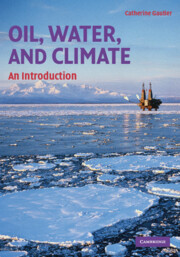Book contents
- Frontmatter
- Contents
- Foreword
- Introduction
- 1 Overview
- 2 Carbon Dioxide Emissions, Global Warming, and Water Resources
- 3 Population, Environmental Impacts, and Climate Change
- 4 Carbon Cycle and the Human Impact
- 5 Peak Oil, Energy, Water, and Climate
- 6 Oil Consumption and CO2 Emissions from Transportation
- 7 Oil, Economy, Power, and Conflicts
- 8 Energy Alternatives and Their Connection to Water and Climate
- 9 The Water Cycle and Global Warming
- 10 Fresh Water Availability, Sanitation Deficit, and Water Usage: Connection to Energy and Global Warming
- 11 Rivers, Lakes, Aquifers, and Dams: Relation to Energy and Climate
- 12 Water Contamination, Energy, and Climate
- 13 Geopolitics of Water and the International Situation
- 14 Water Alternatives
- 15 Global Climate Change: Observations, Modeling, and Predictions
- 16 Energy and Water Challenges and Solutions in a Changing Climate Framework: Commonality, Differences, and Connections
- References
- Index
2 - Carbon Dioxide Emissions, Global Warming, and Water Resources
Published online by Cambridge University Press: 05 September 2012
- Frontmatter
- Contents
- Foreword
- Introduction
- 1 Overview
- 2 Carbon Dioxide Emissions, Global Warming, and Water Resources
- 3 Population, Environmental Impacts, and Climate Change
- 4 Carbon Cycle and the Human Impact
- 5 Peak Oil, Energy, Water, and Climate
- 6 Oil Consumption and CO2 Emissions from Transportation
- 7 Oil, Economy, Power, and Conflicts
- 8 Energy Alternatives and Their Connection to Water and Climate
- 9 The Water Cycle and Global Warming
- 10 Fresh Water Availability, Sanitation Deficit, and Water Usage: Connection to Energy and Global Warming
- 11 Rivers, Lakes, Aquifers, and Dams: Relation to Energy and Climate
- 12 Water Contamination, Energy, and Climate
- 13 Geopolitics of Water and the International Situation
- 14 Water Alternatives
- 15 Global Climate Change: Observations, Modeling, and Predictions
- 16 Energy and Water Challenges and Solutions in a Changing Climate Framework: Commonality, Differences, and Connections
- References
- Index
Summary
The burning of fossil fuels increases the concentration of greenhouse gases in the atmosphere, which in turn induces atmospheric and surface warming. Various, complex feedback mechanisms are at play and lead to this warming. Global warming is one of the greatest threats on water supply; it will affect water resources through its impact on fluvial navigation, hydroelectric power generation, and water quality and is expected to reduce available water supplies for agriculture, residential, and industrial use.
Introduction
The burning of fossil fuels, such as oil, coal, and natural gas, generates carbon dioxide (CO2) and releases other greenhouse gases as well. Such fossil fuel usage has been accelerating over the past century. Because CO2 can remain in the atmosphere for decades or even centuries before being removed by natural processes, its atmospheric concentration has been steadily increasing. The anthropogenic origin of this extra carbon burden found in the atmosphere has been confirmed by isotopic analyses of atmospheric CO2.
The increase in atmospheric CO2 concentration is particularly concerning because the records of past climates and basic physics suggest that such an increase will lead to a rise in Earth surface temperature, commonly referred to as global warming, through an enhancement of the natural greenhouse effect that warms the atmosphere. Global mean temperature has been rising significantly over the past few decades. Little doubt remains that the increase is caused by human activities (IPCC, 2007a).
- Type
- Chapter
- Information
- Oil, Water, and ClimateAn Introduction, pp. 14 - 35Publisher: Cambridge University PressPrint publication year: 2008



